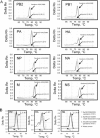Rapid detection of reassortment of pandemic H1N1/2009 influenza virus
- PMID: 20567024
- PMCID: PMC2956410
- DOI: 10.1373/clinchem.2010.149179
Rapid detection of reassortment of pandemic H1N1/2009 influenza virus
Abstract
Background: Influenza viruses can generate novel reassortants in coinfected cells. The global circulation and occasional introductions of pandemic H1N1/2009 virus in humans and in pigs, respectively, may allow this virus to reassort with other influenza viruses. These possible reassortment events might alter virulence and/or transmissibility of the new reassortants. Investigations to detect such possible reassortants should be included as a part of pandemic influenza surveillance plans.
Methods: We established a real-time reverse-transcription (RT)-PCR-based strategy for the detection of reassortment of pandemic H1N1/2009 virus. Singleplex SYBR green-based RT-PCR assays specific for each gene segment of pandemic H1N1/2009 were developed. These assays were evaluated with influenza viruses of various genetic backgrounds.
Results: All human pandemic H1N1 (n = 27) and all seasonal human (n = 58) isolates were positive and negative, respectively, for all 8 segments. Of 48 swine influenza viruses isolated from our ongoing surveillance program of influenza viruses in swine, 10 were positive in all reactions. All 8 viral segments of these 10 samples were confirmed to be of pandemic H1N1 origin, indicating that these were caused by zoonotic transmissions from human to pigs. The 38 swine viruses that were nonpandemic H1N1/2009 had 1-6 gene segments positive in the tests. Further characterization of these nonpandemic H1N1/2009 swine viruses indicated that these PCR-positive genes were the precursor genes of the pandemic H1N1/2009 virus.
Conclusions: Our results demonstrated that these assays can detect reintroductions of pandemic H1N1/2009 virus in pigs. These assays might be useful screening tools for identifying viral reassortants derived from pandemic H1N1/2009 or its precursors.
Figures

Similar articles
-
Detection and Characterization of Swine Origin Influenza A(H1N1) Pandemic 2009 Viruses in Humans following Zoonotic Transmission.J Virol. 2020 Dec 22;95(2):e01066-20. doi: 10.1128/JVI.01066-20. Print 2020 Dec 22. J Virol. 2020. PMID: 33115872 Free PMC article.
-
North American triple reassortant and Eurasian H1N1 swine influenza viruses do not readily reassort to generate a 2009 pandemic H1N1-like virus.mBio. 2014 Mar 11;5(2):e00919-13. doi: 10.1128/mBio.00919-13. mBio. 2014. PMID: 24618255 Free PMC article.
-
Reassorted pandemic (H1N1) 2009 influenza A virus discovered from pigs in Germany.J Gen Virol. 2011 May;92(Pt 5):1184-1188. doi: 10.1099/vir.0.028662-0. Epub 2011 Feb 9. J Gen Virol. 2011. PMID: 21307227
-
Diversity of influenza viruses in swine and the emergence of a novel human pandemic influenza A (H1N1).Influenza Other Respir Viruses. 2009 Sep;3(5):207-13. doi: 10.1111/j.1750-2659.2009.00096.x. Influenza Other Respir Viruses. 2009. PMID: 19768134 Free PMC article. Review.
-
Genetics, evolution, and the zoonotic capacity of European Swine influenza viruses.Curr Top Microbiol Immunol. 2013;370:29-55. doi: 10.1007/82_2012_267. Curr Top Microbiol Immunol. 2013. PMID: 23011571 Review.
Cited by
-
RT-qPCR genotyping assays for differentiating Rift Valley fever phlebovirus strains.J Virol Methods. 2023 May;315:114693. doi: 10.1016/j.jviromet.2023.114693. Epub 2023 Feb 16. J Virol Methods. 2023. PMID: 36801236 Free PMC article.
-
Swine Influenza Virus PA and Neuraminidase Gene Reassortment into Human H1N1 Influenza Virus Is Associated with an Altered Pathogenic Phenotype Linked to Increased MIP-2 Expression.J Virol. 2015 May;89(10):5651-67. doi: 10.1128/JVI.00087-15. Epub 2015 Mar 11. J Virol. 2015. PMID: 25762737 Free PMC article.
-
Rapid detection and subtyping of human influenza A viruses and reassortants by pyrosequencing.PLoS One. 2011;6(8):e23400. doi: 10.1371/journal.pone.0023400. Epub 2011 Aug 19. PLoS One. 2011. PMID: 21886790 Free PMC article.
-
Rapid genotyping of swine influenza viruses.Emerg Infect Dis. 2011 Apr;17(4):691-4. doi: 10.3201/eid1704.101726. Emerg Infect Dis. 2011. PMID: 21470462 Free PMC article.
-
Protection of ferrets from pulmonary injury due to H1N1 2009 influenza virus infection: immunopathology tractable by sphingosine-1-phosphate 1 receptor agonist therapy.Virology. 2014 Mar;452-453:152-7. doi: 10.1016/j.virol.2014.01.003. Epub 2014 Jan 31. Virology. 2014. PMID: 24606692 Free PMC article.
References
-
- Dawood FS, Jain S, Finelli L, Shaw MW, Lindstrom S, Garten RJ et al. Emergence of a novel swine-origin influenza A (H1N1) virus in humans. N Engl J Med 2009;360:2605–15. - PubMed
-
- Smith GJ, Vijaykrishna D, Bahl J, Lycett SJ, Worobey M, Pybus OG et al. Origins and evolutionary genomics of the 2009 swine-origin H1N1 influenza A epidemic. Nature 2009;459:1122–5. - PubMed
-
- Belshe RB. Implications of the emergence of a novel H1 influenza virus. N Engl J Med 2009;360:2667–8. - PubMed
-
- Hofshagen M, Gjerset B, Er C, Tarpai A, Brun E, Dannevig B et al. Pandemic influenza A(H1N1)v: human to pig transmission in Norway? Euro Surveill 2009;14:19406. - PubMed
Publication types
MeSH terms
Grants and funding
LinkOut - more resources
Full Text Sources
Other Literature Sources
Medical

